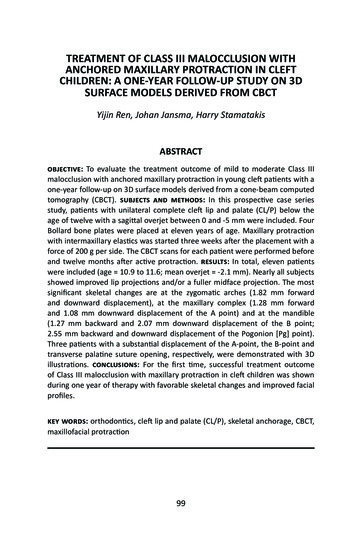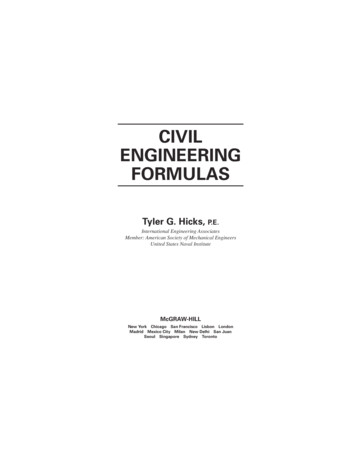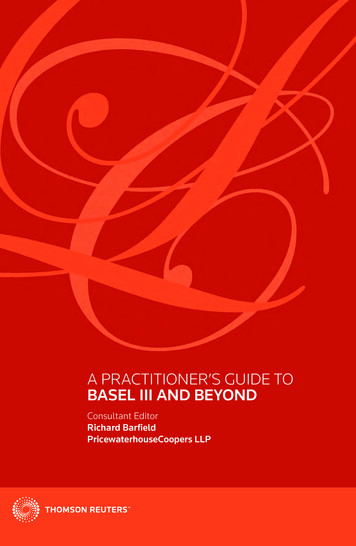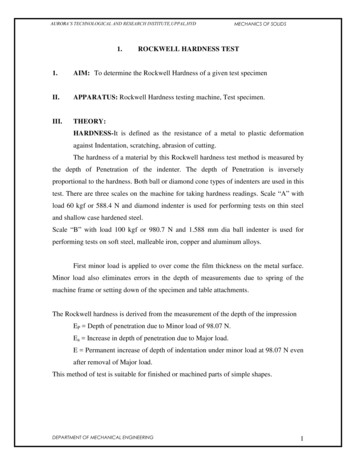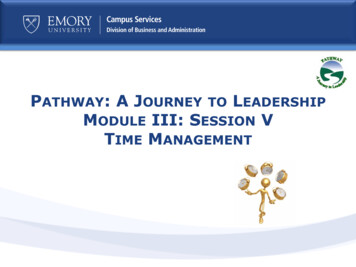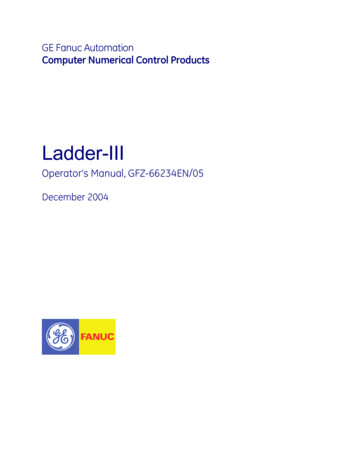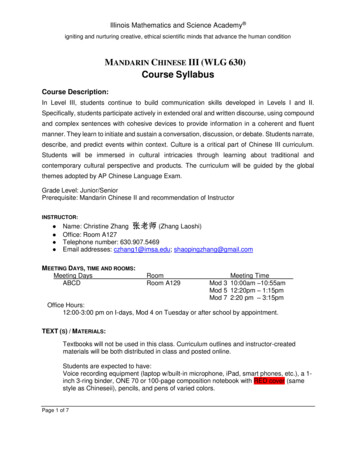
Transcription
III-3-3-2 PDCA Cycle is golden cycle for KAIZENDr. Walter A. Shewhart and Dr. W. Edward Deming advocated PDCA concept for productivitymanagement, and continuous quality improvement of process and products. PDCA is the “goldencycle for improvement”. It is a methodical approach for problem solving and continuous improvement.PDCA wheel should be considered a never-ending cycle for improvement towards an ideal condition.Plan is to establish objectives and process or countermeasures with expected outcome based on thepast performances or future forecasting of workDo is to implement the processes or countermeasures planed.Check is to measure the effectiveness or achievement of processes or countermeasures planed betweenthe actual results and expected results to ascertain any differences.Act is to analyze the differences to identify the causes of “Gap”, and take necessary action to improvechangesActPlanCheckDoFigure 3-16: PDCA cyclePDCA cycle is the concept behind the KAIZEN approach. Look at how PDCA cycle is used inKAIZEN approach.PDCA is rotated like the way described in the figure 3-16. During the planning, 5W1H need to beclarified against the theme or topic as shown below:Why are we undertaking the project?What are we going to do? What data is required?Who is responsible for each task? Who should be involved?Where can we find relevant data and facts?When must a task be complete? When do we need to give feedback?How must it be accomplished? How do we review?Then, implement the plan and see the effectiveness and efficiency of those activities that are taken.Then, activities that show good result should be standardize and adopted in routine practice. Theactivities that do not reduce the problems should be discontinued and it is necessary to plan betteractivities for improvement of the situation.This matches exactly with the KAIZEN Process that will be explained in the next section. However,PDCA cycle consists of four steps only and the cycle may be stopped at Act often. Kaizen aims toraise the standard of your workplace, productivity, quality and safety in a continuous upward spiral62
through rotating PDCA cycle, reflecting on achievement of KAIZEN and taking action to improve theway for next KAIZEN.Plan, preparing how to implement KAIZEN - Clarify the objectives and decide on the controlcharacteristics (control items) - Set measurable target - Decide on the methods to be used to achievethe target.Do, Implementing KAIZEN activities - Study and train in the method to be used - Utilize the method Collect the measurable data set up on the plan for decision-making.Check, Reviewing the result of KAIZEN activities and achievements - Check whether the results ofimplementation has been performed according to the plan or standard - Check whether the variousmeasured values and test results meet the plan or standard - Check whether the results ofimplementation match the target values.Act, taking countermeasures based on the review in “Check” - If the results of implementationdeviate from the plan or standard, take action to correct this - If an abnormal result has been obtained,investigate the reason for it and take action to prevent it recurring - Improve working system andmethods. The diagram below explains which KAIZEN process match with PDCA cycle.Standardize and shareRe-planGood outcomePoor out comeActCheckPlanDevelop ac on plan with 5W1HDoMeasure achievement andEvaluate the effec venessImplement “Ac on Plan”Figure 3-17: How PDCA cycle is rotate in actual settingIt is often misunderstood that KAIZEN is the Japanese name of PDCA cycle.This must be clarified that PDCA cycle is used, as the backbone of KAIZEN process, and it is notexactly same as original concept of PDCA. It can say that KAIZEN process is the improved conceptand practical approach derived from PDCA cycle. Original PDCA cycle is often illustrated as “closedcycle”. However, “PDCA” used in KAIZEN is not “closed cycle”. It is “open quality spiral”. PDCA.Since PDCA cycle consist of four steps only, the cycle maybe stopped at “ACT ” often. KAIZEN aimsto raise the standard of our workplace, productivity, quality and safety in a continuous upward spiralthrough rotating PDCA cycle, reflecting on achievement of KAIZEN and taking action to improve theway for next KAIZEN.63
rdizeDoPlanThink be ermentActImprovementThink be ermentStandardizeCheckDoPDCA cycle in KAIZEN isnot closed cycle.It is Open Quality Spiral!PlanFigure 3-18: “Open Quality Spiral” for CQIFigure 3-19: PDCA Cycle and KAIZEN ProcessIII-3-3-3 Two level of KAIZENThere are two level of KAIZEN. One is called “Small KAIZEN”, and other one takes a standard“KAIZEN process”. “Small KAIZEN” should be the first choice of making things better without anyfinancial input or very little financial input, and quick improvement. On the other hand, “KAIZENprocess” takes time and financial input.64
Figure 3-20: Two level of KAIZENHearing the word “KAIZEN” makes us to think about “doing something hard”. Many people has theimages of “KAIZEN” as “changing big”, however, “KAIZEN” is not a difficult things. It is to changethings little by little or change what you can do in a short period of time with available resources.Then, continue those small changes.It is better not to think of changing things all at once, but rather to think of changing whatever you can.It means that put feasible “KAIZEN” measure into practice. As it goes, little things make a bigdifference.Continuation of small KAIZEN activities will be able to make a big change. However, the people,who are stuck with the idea that KAIZEN is a difficult and hard thing to do, it is difficult to convincethem. Therefore, use pictures, numbers and other evidences to explain about KAIZEN.Here is the good example of small KAIZEN. The picture bellow was taken at one of the base hospitalin Sri Lanka.Figure 3-21: Example of small KAIZEN at base hospital in Sri Lanka65
The hospital gardener came up this small “KAIZEN” idea, and the management of hospital adopted itto maximize productivity of the staff and minimize water usage.The gardener used to pull a long water pipe and took a lot of time for watering plants all over thehospital. However, the gardener came up with an idea to utilize used empty IV drips container andline without needle to drop water to watering the plants. After introducing this KAIZEN idea,workload of the gardener was reduced and possible to do other works, and water usage was reduced.By such a small idea, the hospital accomplished the reduction of workload of staff, costs, and couldimprove productivity.As indicated in the Figure 3-21: Example of small KAIZEN at base hospital in Sri Lanka, a clue ofKAIZEN is “analyze the way of doing your work”. Looking at the current work process, whichconsumes time and financial resources, low productivity and safety, and makes worker tired, it isnecessary to analyze the way of doing your work for improvement.Quick and easy KAIZEN empowers employees, enriches the work experience and brings out the bestin every person. It improves quality, safety; cost structures, delivery, environments, throughput andcustomer services. In small KAIZEN, there are two type of methods in general; Gemba KAIZEN andKAIZEN suggestions.III-3-3-4 Gemba KAIZEN: Managers should visit work front-linefrequently.Gemba is a Japanese word meaning “real place” – now adapted in management terminology to meanthe “workplace” – or that place, where value is added. In manufacturing, it usually refers to the shopfloor. Gembutsu the tangible objects found at gemba, such as work pieces, rejects, jigs, tools, andmachinesGo to gemba is first principle of gemba kaizen. This is a reminder that whenever abnormality occurs,or whenever a manager wishes to know the current state of operations, he or she should go to gembaright away, since gemba is a source of all informationIn many service sectors, gemba is where the customers come into contact with the services offered. Inthe hospital sector, for instance, gemba is everywhere: in OPD, ward, dispensary, operating theatre,laboratory etc. In the hotel business, it is in the lobby, the dining room, guest rooms, the receptiondesk, the check-in counters, and the concierge station. Most departments in these service companieshave internal customers with whom they have inter-departmental activity, which also representsgemba.To start kaizen in gemba, muda offers a handy checklist and mura and muri offers a handy reminderfor this purpose.MUDA is a Japanese word meaning “waste” which, when applied to management of the workplace,refers to a wide range of non-value –adding activities. But this word carries a much deeperconnotation. Work is a series of processes or steps, starting with raw material and ending in a finalproduct or service. At each process, value is added to each activity, and then sent on to the nextprocess. The resources at each process – people and machines – either do add value or do not addvalue. Muda refers to any activity that does not add value. Muda in gemba has seven deadly wastes.Seven deadly wastesWaste is so often in front of us that we do not always see it“The greatest waste is the waste we do not see”66
Overproduction: Blood draws done early to accommodate lab. Lab investigations not taken to theBHTT and idling in nurse’s lockers.Transportation: Moving patients to tests unnecessarily. Sending two or more ambulances for thesame clinic due to lack of planning in the hospital.Excessive Processing: Asking patient the same information multiple times. Nurses drawing the drugchart, observation charts rather than spending time on patient care.Waiting: Inpatients waiting in X-Ray rooms, ECG rooms etc for investigations, especially duringemergency.Inventories: Keeping the items, which are unnecessary for the unit, condemning items, and irrelevantitems for the unit, and excessive items in a unit.Movement: Looking for missing charts or equipment, searching an item for more than 30 seconds,unnecessary movements to perform a work.Defects: medication errors.MURA (Irregularity)Whenever a smooth flow of work is interrupted in an operator's work, the flow of parts and machines,or the production schedule, there is mura .For example, during an emergency in labour room (PostPartum Haemorrhage), each person from VOG , MOO, Nursing Officers to LR attendant areperforming more than their capacity to recover the patient. But the one who goes to blood bank maytake her own time to return to LR without any consideration about the emergency. Thereforeeverybody’s work in the labour room must be adjusted to meet the slowest person’s work. Looking forsuch irregularities becomes an easy way to start gemba kaizen.MURI (Strenuous work)Muri means strenuous condition for worker and machines as well as for the work processes. Forinstance, if a newly appointed nursing worker is assigned to assist a veteran surgeon without sufficienttraining, the job will be strenuous for her, and chances are that she will be slower in her work and maymake many mistakes, creating muda. To avoid this, the managers should follow LUCK principle i.e.Labour Under Correct Knowledge. Muri can occur when operating a machine. For instance if thetrolley is not properly maintained in the hospital, a minor staff may feel difficult to push it whentaking a patient. This causes strain on him meaning that abnormality has occurred.Golden Rules of Gemba managementWhen a problem (abnormality) arises go to gemba first;Check the gembutsu (relevant objects);Take temporary countermeasures on the spot;Find the root cause; andStandardize to prevent recurrenceTen basic rules for practicing KAIZEN in gembaDiscard conventional rigid thinking about production / service;Think how to do it, and not why it cannot be done;Do not make excuses. Start by questioning current practices;Do not seek perfection. Do it right away even if for only 50% of target;Correct mistakes at once;Do not spend money for kaizen;Wisdom is brought out when faced with hardship;Ask ‘Why?’ five times and seek the root cause;Seek the wisdom of ten people rather the knowledge of one; andRemember that opportunities for Kaizen are infinite.67
Figure 3-22: Before and after of 5SIII-3-3-5 KAIZEN SuggestionTo propel PDCA cycle in the hospital, you have to consider how to make a plan for KAIZEN by eachWIT. The solution of your consideration is KAIZEN Suggestion. KAIZEN Suggestion is an entrypoint of KAIZEN and brings valuable opportunities for work unit members' self-development as wellas for interactive communication in the workplace. KAIZEN Suggestion makes employees' KAIZEN- consciousness and provides opportunities both to health and non-health staffs to speak out with theirmanagers as well as among themselves.KAIZEN Suggestion, which is the first process of KAIZEN, encourages staffs to generate a greatnumber of suggestions. Having these opportunities, they work hard and consider how to implementsthe job, which are suggested and created by them. The top management has to prioritize the submittedKAIZEN suggestions based on the relevance, effectiveness and efficiency, and also gives therecognition to employee's efforts for improvement. An important aspect of KAIZEN Suggestion isthat each suggestion, once implemented, has potentials to lead the entire work process to an upgradedstandard.The American-style suggestion system stresses the suggestion's economic benefits and provideseconomic incentives. However, the Japanese-style KAIZEN Suggestion stresses the morale boostingbenefits of positive employee participation.68
Figure 3-23: Outcome of KAIZENIn KAIZEN Suggestion, there are three Stages as followings.1. EncouragementIn the first stage, top manager and QIT should make every effort to help all staffs, who providedsuggestions. No matter how primitive those suggestions are, the top management group has to handlethem for the betterment of the work flow, the workplace and
In small KAIZEN, there are two type of methods in general; Gemba KAIZEN and KAIZEN suggestions . III-3-3-4 Gemba KAIZEN: Managers should visit work front-line frequently. Gemba is a Japanese word meaning “real place” – now adapted in management terminology to mean the “workplace” – or that place, where value is added. In manufacturing, it usually refers to the shop floor .

